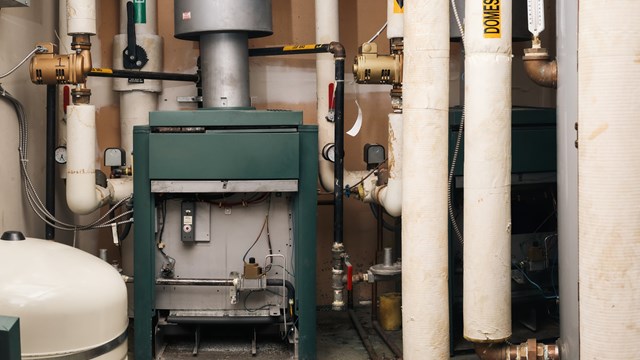
Few things are as important to our health and well-being as the air we breathe, especially inside our own homes. That is why it is so important for individual homeowners as well as management to stay up-to-date on issues of indoor air quality and ensure that everything possible is done to provide a healthy environment, especially in the winter months when so many of us are spending time in the warmth of the indoors.
Problem Areas
Staying warm is always priority one in the winter months. That desire to keep the cold out and the warmth in can lead to problems, though, with air quality. “Windows and doors are typically closed during the winter months, causing poor ventilation because of little outdoor air exchange,” says Mike S. Zouak, CIH, president of Airtek Environmental Corp., based in Long Island City.
That lack of air exchange can exacerbate the presence of gases, chemicals, odors and other issues that can cloud the air we breathe. “Common air pollutants that become more problematic during the winter months include gas and fumes that result from the use of fuel for the boiler, stove or dryer in the winter,” says Zouak. “People tend to cook and use the dryers more often in the winter months, thereby increasing fuel combustion in buildings. Combustion contributes not only to unpleasant indoor odors and fumes, but also to higher carbon monoxide levels in indoor space.”
And of course, that is never a good thing. According to the New York State Department of Health, carbon monoxide (CO) exposure is the leading cause of death due to poisoning in the United States. Because it is colorless, odorless, tasteless and non-irritating, the signs of CO exposure can be ignored, or a person may lose consciousness and be unable to escape.
Jeffrey Hammond, a spokesman for the New York State Department of Health agrees that “carbon monoxide in the winter can be a problem,” especially since the most common sources of CO poisoning in a home comes from “malfunctioning or misused fuel-burning appliances,” according to the Department of Health website. That includes malfunctioning furnaces and portable non-electric space heaters, both of which get a workout in the winter months.
That is why all homes “should have carbon monoxide detectors,” says Hammond. “They’re ten dollars from any home improvement store and they can save lives.”
In addition, spaces can be tested for carbon monoxide as well as radon, another potentially deadly gas that can occur naturally in soil and enter homes through cracked foundations. “Carbon monoxide and radon can be tested with typical commercially available household detectors or test kits,” says Zouak. “Professional environmental consultants will typically use more specialized gas sensors that provide more accurate and reliable test results.”
Radon gas comes from the radioactive decay of radium in the soil, according to the DOH website. It is a colorless, tasteless and odorless gas that can only be detected through proper testing procedures. Radon also can be dissolved in ground water and makes its way into a building or home through well water in washing machines and showers. Radon is the second leading cause of lung cancer in the United States, resulting in an estimated 22,000 lung cancer deaths annually. The need for regular and effective testing is paramount to ensuring adequate indoor air quality.
On a less severe note, during the winter months, moisture can be a problem in homes. “During the winter months in residential homes, we sometimes find moisture/algae/mold forming in the vents, and this is mostly from built-in furnace humidifiers that haven’t been maintained and cleaned,” according to Michael Antczak, owner of Antczak’s Complete Service Company, LLC, based in New Jersey.
Other irritants include dust “as well as construction debris we find in homes that have never had the vents cleaned,” says Antczak.
Signs of indoor air quality issues are many, Antczak says, and they include heavy dust build-up on the furnace filter and on the return vents; dust and black lines around the air ducts; dust build-up on furniture; debris such as insect bodies and food particles in floor vents; and odor coming from inside the vents.
Homeowners, unit owners and shareholders who suffer from allergies and chronic sinus issues may also be showing signs of unhealthy indoor air quality in the home. “Symptoms resulting from seasonal air quality changes may range from sneezing and nasal or eye irritations to coughing, drowsiness and headache,” says Zouak. “Individual allergic reactions to mold or pollen, for example, may be severe depending on sensitivity.”
Built-in Issues
Sometimes indoor air quality issues stem from chemicals and other products introduced into the building for construction, cleaning or similar activities. “Indoor irritants from chemical sources are typically in the form of volatile organic compounds (VOCs),” says Zouak. “Building components such as paint, carpet, wood finish, insulation and caulking can release VOCs that could cause irritation.”
In addition, the type and location of a building can impact air quality. “Certainly, the location can contribute to air problems,” Zouak says. “Buildings within and around major cities, for example, will be exposed to greater amounts of transportation exhaust. Buildings closer to a body of water will be exposed to more humidity and moisture that could lead to condensation and, therefore, mold problems. Manufacturing plants can expose neighboring buildings to industrial exhaust, not to mention the environmental waste that could also add to hazardous fumes.
“Air problems could depend on the type of building to the extent that the building materials may be more likely to release VOCs, have poor ventilation systems, or use fossil fuel inefficiently,” Zouak says. “Building components such as paint, carpet, wood finish, insulation, and caulking can release VOCs that could cause irritation.”
Air flow can affect the severity of these types of VOC issues. “Poorly ventilated buildings will exacerbate any indoor air problems,” says Zouak. “Individual sensitivity levels to VOCs may vary but, in general, if indoor air quality is compromised by an excessive amount of VOCs, the occupants will be able to smell the resulting odor. Any detectable odor, whether mild or severe, should be addressed immediately.”
Cleaning liquids and paint can contribute to indoor air problems by releasing VOCs, says Zouak.
When it comes to chemicals and other unusual causes of air quality issues, the concept of “sick building syndrome” may come to the fore. “There are numerous academic and scientific studies establishing the existence of Sick Building Syndrome (SBS),” Zouak says. “In the field of indoor air quality consulting and testing, we are not asked to determine whether or not a phenomenon can be classified as SBS. However, when building occupants complain of symptoms typically associated with SBS, we investigate the ventilation of the space and may test for some contaminants depending on the symptoms. The problem typically lies in poor ventilation of the space, and it is difficult to identify specific indoor air contaminants that cause SBS.”
Avoiding and Solving the Problems
In any situation, the best way to solve a problem is to prevent it from happening in the first place. Antczak says, “Homeowners should have their air ducts cleaned by a professional air duct cleaner,” every two to five years. And it is important to ensure that the cleaners are experienced. “Find out the method of cleaning,” he says. “The $39.99 specials are never what they seem, so use caution.”
Other preventive measures should include keeping furnace filters clean and replacing them often, says Antczak. “Use an air filtration system on the furnace or a portable unit. Keep your home humidifiers clean during winter months.”
“Vents, ducts, and air handling units should be routinely inspected at a minimum of once a year depending on usage,” says Zouak. “However, any incidence involving water damage, mold or microbial growth, building of dust or debris, or severe odors coming from the ventilation system should prompt an inspection, if not also a thorough cleaning of the system. The building maintenance personnel should consult the manufacturer instructions to determine the appropriate time to replace air filters and other components.”
When a full-scale investigation needs to be done, it is important to hire a professional to work side-by-side with building staff. “The type of testing and equipment needed depends on the allergen or airborne irritants in question,” says Zouak. “It is always best to hire a professional to conduct an indoor air quality investigation in order to avoid potentially dangerous situations that could result from ineffective testing or misdiagnosis.”
For boards and property managers, it is important to maintain not only a regular maintenance and testing schedule for the building, its equipment and its environment but also to ensure an open dialogue with residents. According to Hammond, tenants or prospective tenants must be provided with generic fact sheets developed by the New York State Department of Health on indoor air contaminants and must be made aware when there is exposure to chemicals in the area. All of this is based on New York State environmental conservation law.
For unit owners and shareholders, the New York State Department of Health also has a broad range of publications and fact sheets available online that can answer indoor air quality questions and address concerns—something which can go a long way in providing peace of mind and good health.
In short, when it comes to maintaining a healthy indoor environment and finding a way to feel confident in the air we breathe, proper monitoring, effective education and quick maintenance and repair are imperative. Stay clean, keep dry, learn more, follow maintenance standards and then, just breathe easy.
Liz Lent is a freelance writer and a frequent contributor to The Cooperator.









Leave a Comment